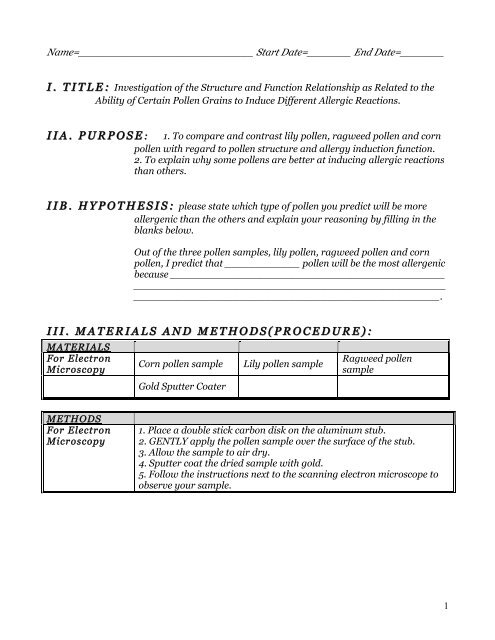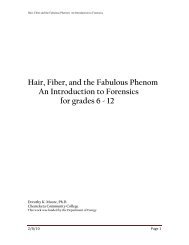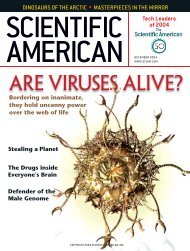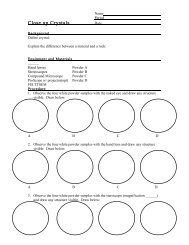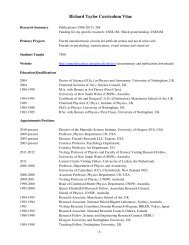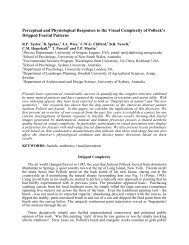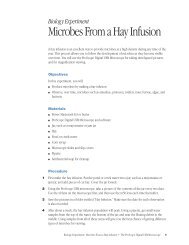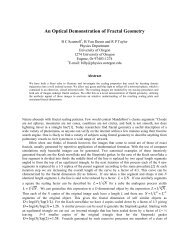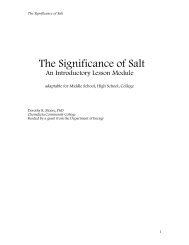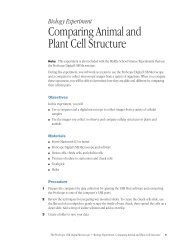Pollen Lab - Materials Science Institute
Pollen Lab - Materials Science Institute
Pollen Lab - Materials Science Institute
You also want an ePaper? Increase the reach of your titles
YUMPU automatically turns print PDFs into web optimized ePapers that Google loves.
Name=____________________________ Start Date=_______ End Date=_______<br />
I. TITLE: Investigation of the Structure and Function Relationship as Related to the<br />
Ability of Certain <strong>Pollen</strong> Grains to Induce Different Allergic Reactions.<br />
IIA. PURPOSE: PURPOSE 1. To compare and contrast lily pollen, ragweed pollen and corn<br />
pollen with regard to pollen structure and allergy induction function.<br />
2. To explain why some pollens are better at inducing allergic reactions<br />
than others.<br />
IIB. HYPOTHESIS: please state which type of pollen you predict will be more<br />
allergenic than the others and explain your reasoning by filling in the<br />
blanks below.<br />
Out of the three pollen samples, lily pollen, ragweed pollen and corn<br />
pollen, I predict that ____________ pollen will be the most allergenic<br />
because ____________________________________________<br />
__________________________________________________<br />
_________________________________________________.<br />
III. MATERIALS AND METHODS(PROCEDURE):<br />
MATERIALS<br />
For Electron<br />
Microscopy<br />
METHODS<br />
For Electron<br />
Microscopy<br />
Corn pollen sample Lily pollen sample<br />
Gold Sputter Coater<br />
Ragweed pollen<br />
sample<br />
1. Place a double stick carbon disk on the aluminum stub.<br />
2. GENTLY apply the pollen sample over the surface of the stub.<br />
3. Allow the sample to air dry.<br />
4. Sputter coat the dried sample with gold.<br />
5. Follow the instructions next to the scanning electron microscope to<br />
observe your sample.<br />
1
IV. OBSERVATIONS:<br />
Draw 1 pollen grain as instructed in class. Remember to include your scale bar.<br />
SEM _______X Mag<br />
Lily <strong>Pollen</strong> Grain<br />
SEM _______X Mag<br />
Corn <strong>Pollen</strong> Grain<br />
V. CONCLUSIONS:<br />
A. Which pollen type did you predict to be most allergenic?<br />
SEM _______X Mag<br />
Ragweed <strong>Pollen</strong> Grain<br />
2
B. Briefly describe 2 similarities and 2 differences between the different pollen types.<br />
a. Similarity #1=<br />
b. Similarity #2=<br />
c. Difference #1=<br />
d. Difference #2=<br />
C. Which type of pollen had the smallest grain?<br />
D. Which type of pollen grain would be easiest to disperse in the air? Explain.<br />
E. Which type of pollen would be most likely to stick on to the respiratory epithelium of the<br />
nose? Explain.<br />
F. Explain the structural features of the ragweed pollen that help to make it one of the most<br />
allergenic pollen grains in the environment.<br />
G. Briefly describe another experiment that could help you prove which structural feature<br />
was most important for the allergenicity of ragweed pollen.<br />
H. Briefly explain the cascade of events in the allergenic response induced by an allergen<br />
such as ragweed pollen.<br />
3
SEM 1281X Mag<br />
Lily pollen<br />
Size=140µm<br />
Smoother ridges<br />
SEM 7363X Mag<br />
Ragweed pollen<br />
Size=~20µm<br />
Velcro like spikes<br />
4
SEM 1216X Mag<br />
Corn pollen<br />
Size=~80µm<br />
Smooth surface<br />
This lab has been utilized in a microbiology(BI234) laboratory class of 24 allied health<br />
students with good success. Students clearly understood the relationship between structure<br />
and function as a common theme that permeates science. Students were amazed at the<br />
differences in size and shape of different types of pollen and discovered the relationship<br />
between the small size and spiky coat of the ragweed pollen that helps it to be a highly<br />
potent allergen. The structure and function of pollens also reinforced the concepts of the<br />
immune response which is also discussed in microbiology.<br />
5


